Key takeaways:
- Toddler tantrums are often a result of limited emotional expression, frustration, and the quest for independence.
- Effective strategies for managing tantrums include distractions, validating feelings, and setting clear expectations.
- Prioritizing calmness and creating “cool down” spaces can help children regain control during emotional outbursts.
- Supporting emotional development involves recognizing feelings, teaching coping strategies, and modeling emotional understanding.

Understanding toddler tantrums
Toddler tantrums are often misunderstood as mere acts of defiance. I vividly remember a time when my child erupted into a full-blown fit in a grocery store simply because I refused to buy that colorful snack he was fixated on. In that moment, it hit me that these outbursts stem from their limited ability to express emotions and frustrations.
When we think about why toddlers throw tantrums, it’s essential to consider their developmental stage. They are learning to navigate a world filled with expectations they can’t always articulate. Have you ever witnessed a child scream for what seems like no reason? It’s not just about the moment; it’s their struggle to communicate complex feelings that we adults sometimes overlook.
I felt a wave of empathy wash over me the first time I realized that a tantrum might just be my little one’s way of handling overwhelming emotions. It’s a reminder that, at the core, tantrums are frustrating yet normal parts of growing up. How often do we forget that toddlers are essentially miniature humans grappling with the same big feelings we experience?
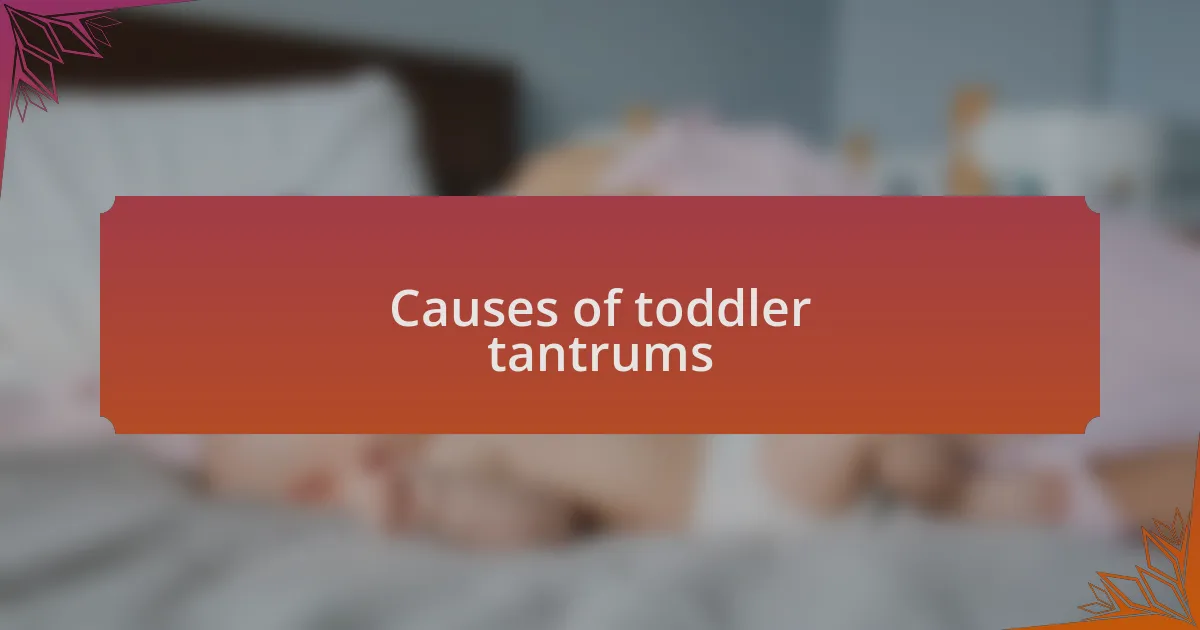
Causes of toddler tantrums
One significant cause of toddler tantrums is the quest for independence. I recall a particularly challenging afternoon when my daughter insisted on putting on her shoes by herself, but frustration quickly took over when she couldn’t manage it. This battle between wanting to feel capable and the reality of their limited skills is a huge trigger for those intense outbursts.
Another factor to consider is the frustration that arises from unmet needs. I remember a day when my son had a meltdown simply because he had missed his nap. It struck me how vital rest is for toddlers; when they’re tired or hungry, even the smallest frustrations can lead to explosive reactions. How often do we overlook basic needs in our daily rush?
Lastly, transitions and changes in routine can set off tantrums as well. I was caught off guard once when I decided to change our usual snack time, only to be met with a dramatic reaction from my little one. That experience taught me just how sensitive toddlers are to shifts in their environment; their routines offer comfort and security, and when those are disrupted, it’s no surprise that chaos ensues.
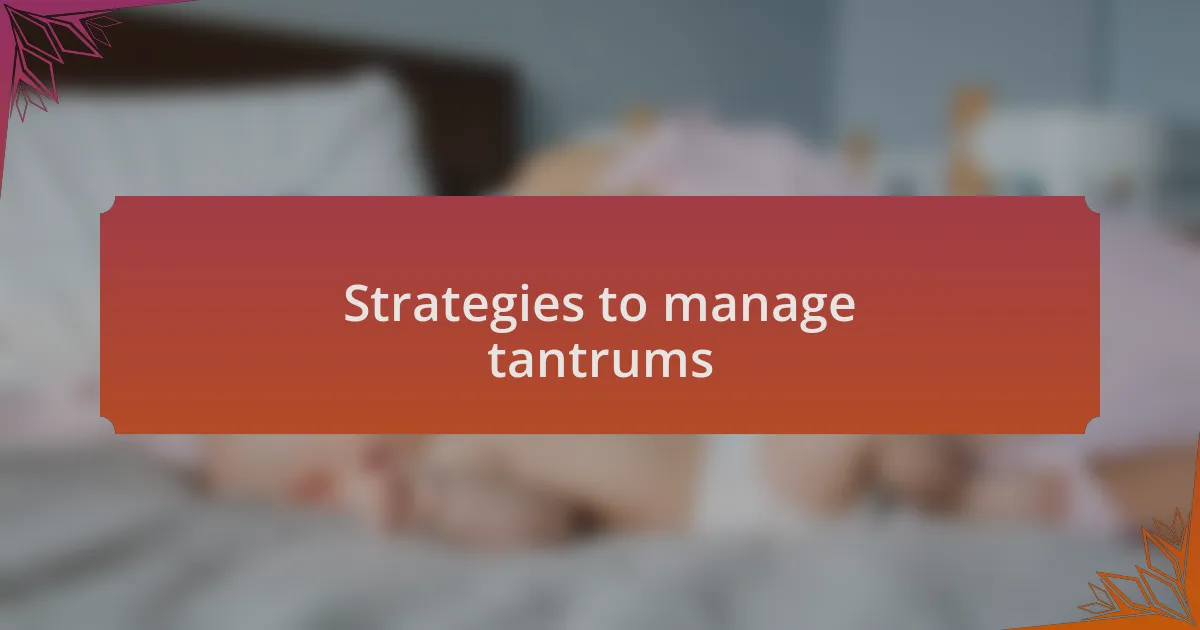
Strategies to manage tantrums
One effective strategy I’ve found in managing toddler tantrums is the power of distractions. For instance, when my daughter was on the verge of a meltdown in a store, I quickly pointed out a colorful display of toys nearby. It worked like a charm, redirecting her attention and diffusing the situation. This approach not only bought me time but also reminded me of how easily toddlers can be captivated by their surroundings.
Another helpful tactic is to acknowledge their feelings without dismissing them. I recall a moment when my son was sobbing over a toy he wanted but couldn’t have. Instead of simply telling him to stop crying, I got down to his level and validated his feelings. “I know you really wanted that toy, and it’s okay to feel upset.” This recognition helped him to calm down, and it encouraged him to express his emotions more constructively in the future.
Moreover, setting clear expectations can prepare toddlers for what’s coming next. I remember explaining to my daughter that we would leave the park after 10 more minutes of play. Giving her a countdown created a sense of control over her emotions. I’ve often observed that when toddlers know what to expect, they feel more secure and are less likely to react with tantrums. Isn’t it interesting how a little communication can make such a difference?
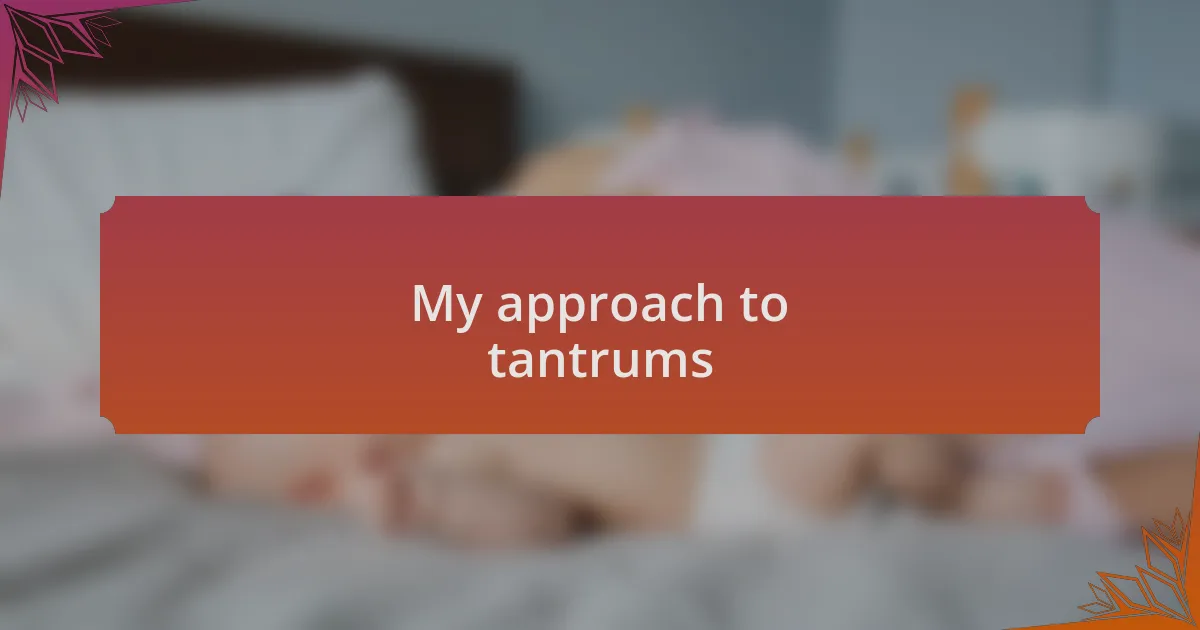
My approach to tantrums
When it comes to my approach to tantrums, I prioritize maintaining a calm demeanor. There was a time when my son had a full-blown meltdown in the middle of a family gathering. Instead of losing my cool, I took a deep breath and reminded myself that responding with patience and understanding could lead to a better outcome. It’s amazing how my calmness can sometimes act as a soothing balm for his heightened emotions, creating a more conducive environment for resolution.
I also make it a point to create “cool down” spaces where my children can retreat to when they feel overwhelmed. I vividly recall a particularly intense evening when my daughter was inconsolable over a spilled drink. I gently guided her to a cozy corner of our living room, filled with soft pillows and her favorite book. This little sanctuary became her safe haven, allowing her to regroup and regain composure without external pressures. Does it not make sense that a quiet space can empower children to manage their own emotions better?
Listening actively is another cornerstone of my approach. I remember a day when we faced an unexpected change in our plans, leading to my daughter’s frustration. By crouching down and attentively asking her what she was feeling, I learned that she was not only upset about the change but also worried about missing out on fun. This dialogue not only helped me understand her better; it also built a foundation of trust that fosters open communication in the future. Isn’t it remarkable how truly listening can transform a difficult moment into an opportunity for connection?
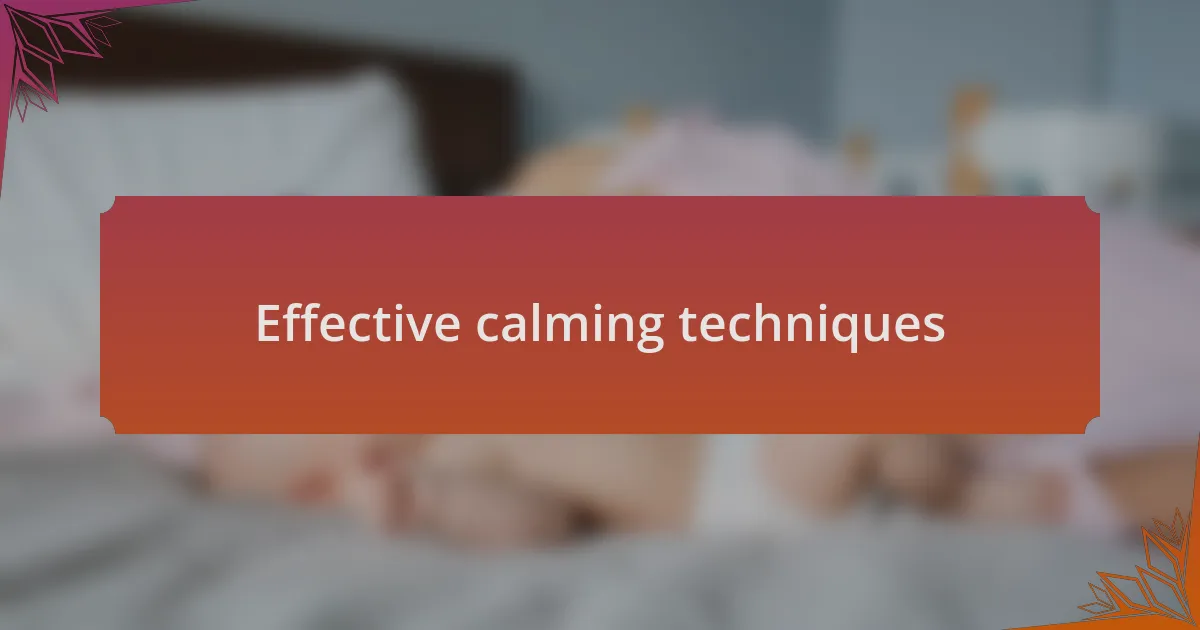
Effective calming techniques
Finding effective calming techniques has truly made a difference in handling toddler tantrums. One approach I’ve found particularly useful is the power of distraction. I recall a time when my son was throwing a fit over not being able to have a cookie before dinner. Instead of giving in, I quickly engaged him with a fun game, using a pretend cooking scenario with his toys. In no time, his focus shifted away from the tantrum, and we were both laughing and enjoying our playtime together.
I also swear by the art of deep breathing. It’s fascinating how something so simple can be so impactful. Whenever my daughter feels like she’s reaching that boiling point, I calmly sit with her and model deep breathing exercises. We take slow, exaggerated breaths together, and I can see her little body relax with each inhale and exhale. Hasn’t it been said that teaching them to control their breath can help them manage their emotions? I believe that, and witnessing her calming down has been incredibly satisfying.
Music has a way of soothing the most chaotic moments. One evening, when both of my kids were cranky and tired, I decided to have a mini dance party in the living room. I turned on their favorite upbeat songs and encouraged them to join me for some silly dancing. The joy and laughter that erupted not only lifted their spirits but also transformed the atmosphere completely. Isn’t it amazing how a simple tune can shift our mood from frustration to joy?
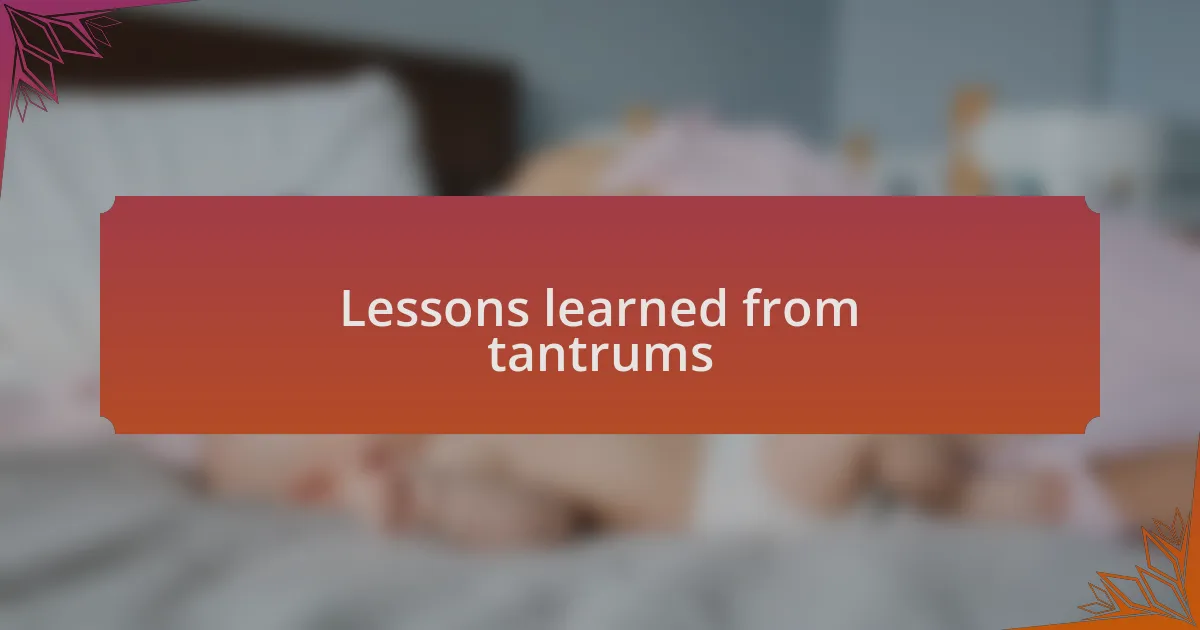
Lessons learned from tantrums
Handling tantrums has taught me the importance of patience. I vividly remember a day when my daughter melted down over wanting to wear her favorite dress on a day too chilly for it. Instead of reacting with frustration, I took a moment to breathe and acknowledged her feelings. This patience not only helped me stay calm but also reassured her that it was okay to express emotions, leading us to a compromise that satisfied us both.
Another lesson I’ve gleaned is the significance of setting clear expectations. After experiencing a tantrum at the grocery store because my son wanted a toy, I realized we needed a pre-shopping conversation. Now, before heading out, I explain what to expect and establish boundaries around buying items. It’s a small change, but it has made a world of difference; he’s more engaged and cooperative when he knows our game plan.
Lastly, I’ve learned the value of connection during these challenging moments. On a particularly tough day, I found myself sitting on the floor with my son during a tantrum, simply listening and holding his hand. This quiet connection transformed his cries into whispers of frustration. Have you ever felt that a simple touch or presence can mend an emotional storm? I know I have, and it reminds me that amidst the chaos, nurturing that bond is crucial.
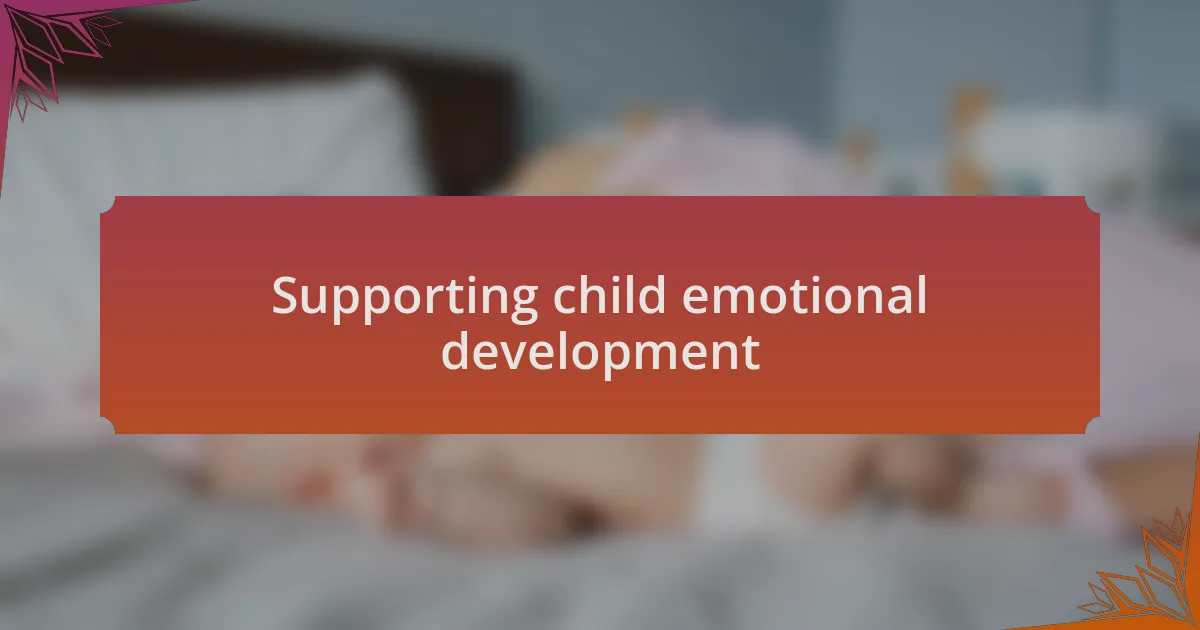
Supporting child emotional development
Recognizing and validating a child’s emotions can significantly support their emotional development. I remember a time when my daughter was overwhelmed by a sudden change in plans. Instead of brushing it off, I leaned down to her level and said, “I see you’re feeling upset because we can’t go to the park today. It’s hard when things don’t go as we expect, isn’t it?” This simple acknowledgment shifted her mood and showed her it was okay to feel upset, creating a safe space for her emotions.
Another aspect I believe is crucial is teaching coping strategies. When my son was struggling with frustration after losing a game, I encouraged him to take deep breaths. We practiced together, counting to three with each inhale and exhale. That moment taught him a valuable skill: instead of letting anger take over, he could embrace calmness. Have you noticed how breathing can change a situation? It’s empowering for children to know they have tools to navigate their emotions.
Finally, I think it’s essential to model emotional understanding. One evening, I shared with my kids how I felt frustrated with work deadlines. I explained my emotions, showing them it’s perfectly normal to experience ups and downs. By sharing my experience, I demonstrated that it’s not only okay to express feelings but also important to talk about them. How often do we think about the lessons our own emotions teach? For me, opening up has created a deeper connection, encouraging my children to do the same.